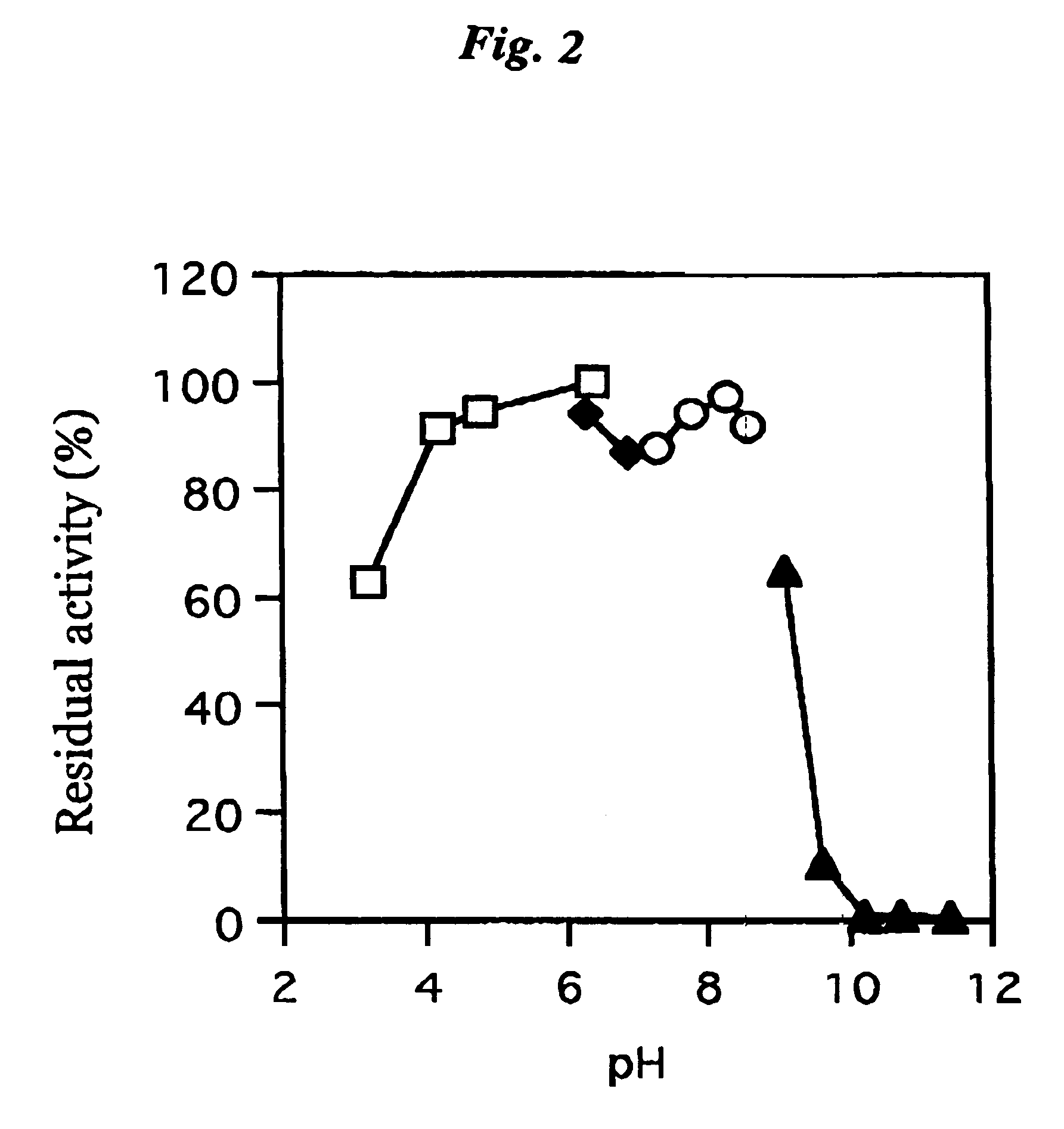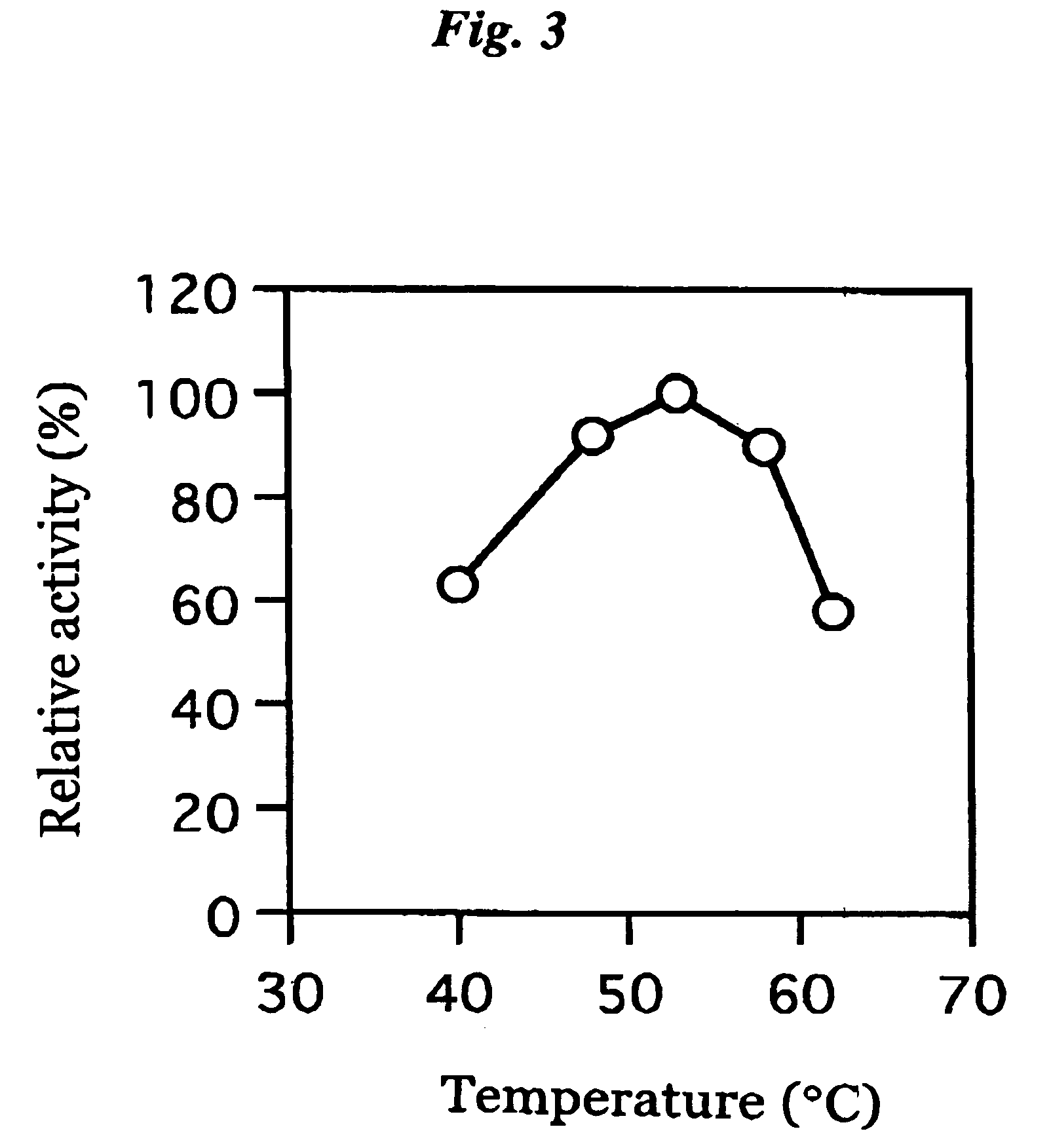Coenzyme-binding glucose dehydrogenase
a technology of coenzyme-binding glucose and dehydrogenase, which is applied in the field of new soluble coenzyme-binding glucose dehydrogenase, can solve the problems of poor stability of the enzyme, and achieve the effect of high accuracy and rapid and convenient glucose quantification
- Summary
- Abstract
- Description
- Claims
- Application Information
AI Technical Summary
Benefits of technology
Problems solved by technology
Method used
Image
Examples
example 1
Culture of Deposited Strain 97508
[0069]100 ml of a culture medium (pH6.0) containing 1% glucose (WAKO PURE CHEMICAL), 2% defatted soybean (NIPPON SHOKUHAN), 0.5% of corn steep liquor (KYODO SHOJI) and 0.1% magnesium sulfate (Nacalai Tesque) was placed in a 500-ml culture flask, which was sterilized at 121° C. for 20 minutes, cooled, inoculated with a platinum loop of the deposited strain 97508, shaken at 30° C. for 88 hours to obtain a seed culture of the strain. 4 L of the culture medium having the composition similar to that described above but supplemented with an antifoam agent was added to a 5-L jar fermenter, which was sterilized at 121° C. for 30 minutes, cooled, inoculated with 40 ml of the seed culture described above, cultured at 28° C. for 31 hours with aerating and shaking to obtain a preliminary culture of the strain. Then, 160 L of the culture medium having the composition similar to that described above but supplemented with an antifoam agent was added to a 200-L jar ...
example 2
Isolation of Coenzyme-Binding Glucose Dehydrogenase from the Culture Supernatant
[0070]By the following Steps 2.1 to 2.5, the coenzyme-binding glucose dehydrogenase was isolated.
2.1 Concentration
[0071]160 L of the culture supernatant of Example 1 was concentrated through an ultrafiltration membrane “Pellicon 2 Module” (Millipore), and transferred into a 20 mM potassium phosphate buffer (pH7.5) to obtain a crude enzyme solution.
2.2 Purification by Butyl-TOYOPEARL 650M (TOSOH) (First Process)
[0072]The abovementioned crude enzyme solution was prepared in 65%-saturated ammonium sulfate (pH7.5), and centrifuged to obtain a supernatant. This treated crude enzyme solution was loaded onto a Butyl-TOYOPEARL 650M column (diameter: 4.7 cm, height: 7.7 cm) which had previously been equilibrated with a 20 mM potassium phosphate buffer (pH7.5) containing 65% ammonium sulfate; and thereby allowing the enzyme is absorbed therein. This column was washed with the same buffer solution, and then the enz...
example 3
Test of Characteristics of Coenzyme-Binding Glucose Dehydrogenase
[0076]The coenzyme-binding glucose dehydrogenase isolated in Example 2 described above was examined for its effect, optimum pH, pH for stability, optimum temperature, thermal stability, substrate specificity, molecular weight, inhibitor and coenzyme.
3.1 Effect
[0077]The coenzyme-binding glucose dehydrogenase was reacted with 500 mM D-glucose in the presence of 8.66 mM DCIP, and the reaction product was quantified using D-gluconic acid / D-glucono-δ-lactone measurement kit. As a result, the production of D-gluconic acid was identified, and it was revealed that the inventive coenzyme-binding glucose dehydrogenase is the enzyme that catalyzes a reaction for oxidizing a hydroxyl group in the 1-position of D-glucose.
3.2 Optimum pH
[0078]The buffer solution according to the Enzymatic activity measurement method 2 was replaced with the citric acid-sodium phosphate buffer (pH4.0 to 5.5), potassium phosphate buffer (pH6.5 to 7.5), ...
PUM
| Property | Measurement | Unit |
|---|---|---|
| molecular weight | aaaaa | aaaaa |
| molecular weight | aaaaa | aaaaa |
| temperature | aaaaa | aaaaa |
Abstract
Description
Claims
Application Information
 Login to View More
Login to View More - R&D
- Intellectual Property
- Life Sciences
- Materials
- Tech Scout
- Unparalleled Data Quality
- Higher Quality Content
- 60% Fewer Hallucinations
Browse by: Latest US Patents, China's latest patents, Technical Efficacy Thesaurus, Application Domain, Technology Topic, Popular Technical Reports.
© 2025 PatSnap. All rights reserved.Legal|Privacy policy|Modern Slavery Act Transparency Statement|Sitemap|About US| Contact US: help@patsnap.com



